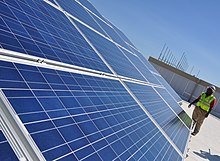
Solar power has been increasing rapidly in the U.S. state of North Carolina, from less than 1 MW (megawatts) in 2007 to 6,152 MW in 2019, when it had the second-largest installed PV capacity of all states.[1]
In addition to federal incentives, the state has a Renewable Portfolio Standard of 12.5% by 2021 and a state renewable energy tax credit, both of which have been credited with boosting solar installations.[2][3][4]
In North Carolina, the distribution of solar power production is mainly on land that is classified as agricultural land, at 63%.[5] Furthermore, a 2018 Smithsonian Magazine article described North Carolina as likely being the national leader in the "solar shepherd phenomenon" – combining sheep farming with solar power plants to reduce the high costs of grass trimming.[6]
According to a report from the Solar Energy Industries Association, as of June 2019, North Carolina generates 5.81% of its electricity through solar power, and ranks second (up from 3rd in 2018) in total installed photovoltaics.[7] As of 2022 this number is up to 9% being ranked 4th.[8]
| Year | Total (MW) | Installed (MW) | % Change |
|---|---|---|---|
| 2007 | 0.7 | ||
| 2008 | 4.7 | 4 | 571% |
| 2009 | 12.5 | 7.8 | 166% |
| 2010 | 40 | 28.7 | 220% |
| 2011 | 85.5 | 45.5 | 114% |
| 2012 | 207.9 | 122.4 | 143% |
| 2013 | 469 | 261.1 | 126% |
| 2014 | 849 | 380 | 81% |
| 2015 | 1,974 | 1,125 | 132% |
| 2016 | 2,984 | 1,010 | 51% |
| 2017 | 3,287.5 | 303.5 | 10% |
| 2018 | 4,692.1 | 1,404.6 | 42.7% |
| 2019 | 6,152.3 | 1,460.2 | 31% |
| 2020 | 7,037.8 | 885.5 | 14% |
| 2021 | 7,811.2 | 773.4 | % |
| 2022 | 8,179 | 367.8 | % |

- Source: NREL[17]
- ^ http://www.eia.gov/electricity/annual /2017/06/19
- ^ Lauren Shwisberg (February 27, 2014). "Utility Scale Solar Energy: North Carolina's Emergent Success". The Energy Collective. Retrieved September 5, 2014.
- ^ Daniel Gross (July 5, 2014). "NC quietly becomes a star on solar energy stage". The News & Observer. Retrieved September 5, 2014.
- ^ Steve DeVane (July 18, 2014). "Solar farms taking root in North Carolina". The Fayetteville Observer. Retrieved September 5, 2014.
- ^ Curtis, Scott; Etheridge, Randall; Malali, Praveen; Peralta, Ariane L.; Filho, Faete (2020). "Planning for Future Solar Farm Development in North Carolina: A Geographic Food Energy-Water Approach". Southeastern Geographer. 60 (1): 48–64. ISSN 1549-6929.
- ^ Molly A. Seltzer. "There's a New Job in the Solar Industry." Smithsonian Magazine. February 6, 2018.
- ^ "Solar Spotlight – North Carolina" (PDF). Solar Energy Industries Association. Retrieved October 18, 2019.
- ^ https://www.eia.gov/state/print.php?sid=NC
- ^ Sherwood, Larry (July 2009). "U.S. Solar Market Trends 2008" (PDF). Interstate Renewable Energy Council (IREC). Archived from the original (PDF) on November 23, 2009. Retrieved July 24, 2010.
- ^ Sherwood, Larry (July 2010). "U.S. Solar Market Trends 2009" (PDF). Interstate Renewable Energy Council (IREC). Archived from the original (PDF) on September 25, 2010. Retrieved July 28, 2010.
- ^ Sherwood, Larry (June 2011). "U.S. Solar Market Trends 2010" (PDF). Interstate Renewable Energy Council (IREC). Retrieved June 29, 2011.
- ^ Sherwood, Larry (August 2012). "U.S. Solar Market Trends 2011" (PDF). Interstate Renewable Energy Council (IREC). p. 17. Archived from the original (PDF) on September 6, 2012. Retrieved August 16, 2012.
- ^ Sherwood, Larry (July 2013). "U.S. Solar Market Trends 2012" (PDF). Interstate Renewable Energy Council (IREC). p. 16. Retrieved October 11, 2013.
- ^ Sherwood, Larry (July 2014). "U.S. Solar Market Trends 2013" (PDF). Interstate Renewable Energy Council (IREC). Retrieved July 28, 2014.
- ^ "North Carolina Solar Projects". solarlove.org. Retrieved October 18, 2019.
- ^ "North Carolina Solar". Solar Energy Industries Association (SEIA). Retrieved May 6, 2020.
- ^ "PV Watts". NREL. Retrieved May 17, 2012.